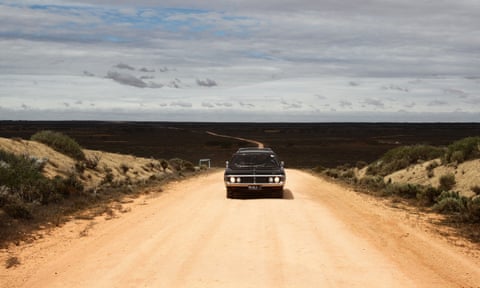It started out in an industrial complex carpark – hardly fitting, it seemed, for a man who helped us redefine our understanding of human history – but this was the repository for treasured artefacts that were held in collection by the Australian National Museum.
Hemmed in by a Bunnings trade warehouse, kitchen joinery workshops and automative businesses, it was the place from which the remains of Australia’s oldest known man, Mungo Man, began a three-day, 800km journey back to country.
The first port of call was Wagga Wagga, a 250km run down the Hume Highway from Canberra into New South Wales’s Riverina district where a previously unscheduled ceremony and welcome to country was held for the 40,000-year-old cargo.
So precious to his descendants is Mungo Man, and the other 104 sets of ancestral remains accompanying him on this spiritual journey back home, that a security guard was hired to stand throughout the night over the vintage Chrysler hearse that carried him.

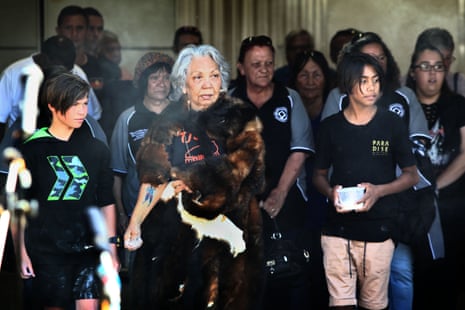

- The repatriation ceremony held in the car park of the National Museum of Australia. All photos by Dean Sewell for the Guardian.
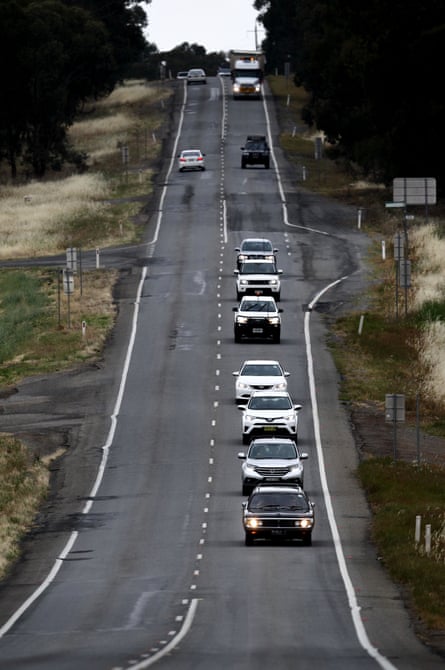

- Leaving Wagga Wagga and stopping for petrol.
I caught up with the hearse early on the second day before its 400km track across the Hay Plains, leapfrogging it over and over in pursuit of an encapsulating frame of the journey.
Upon arrival at Hay, we crossed the Murrumbidgee river to an awaiting ceremonial crowd. The hearse was greeted on the main drag and escorted by brothers Dan and Daniel Kennedy in traditional markings into the town park which was filled with schoolchildren, traditional owners, elders and the general public.
Young Wiradjuri boys formed a guard of honour and it was Uncle Roy Kennedy, a Ngiyampaa elder, who led Mungo Man’s remains into the jubilant crow for its ritual smoking. Wiradjuri boys from the Tirkandi Inaburra Cultural and Development Centre performed ancient dances and, on conclusion of the formalities, there was a customary sausage sizzle.

- The service at Hay.
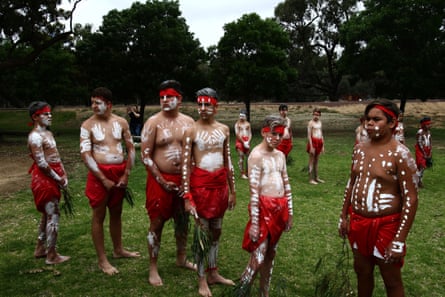
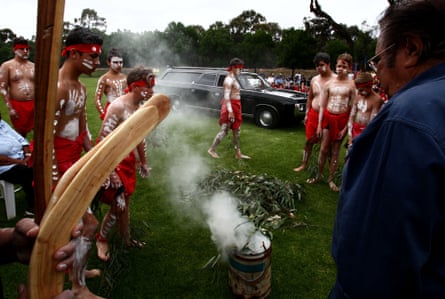

At the western limits to the Hay Plains lies the town of Balranald, a further 140km down the Murrumbidgee. It is a gateway to the Mungo national park. When I pulled into the Balranald Aboriginal cemetery, Mutthi Mutthi elder David Edwards was hunched over a smoking pile of gum leaves with Jason Kelly, grandson of the famed Alice Kelly, a pioneering elder in the repatriation of Mungo Man and named Aboriginal Person of the Year in 1988. Later that day, Alice Kelly had a plaque unveiled in her honour in the town centre.




- Jason Kelly leads the ceremony in Balranald.
At 58 years of age, Edwards can be an imposing figure. His tall, agile frame covered with body paint lurched around a freshly turned patch of land in preparation for the formal ceremony. He reminded the crowd that the fire built earlier was made the “traditional way, with fire sticks and not a lighter, in respect of our elders”. The energy coursing through his body was palpable, his eyes probing the sky as he communicated with his ancestral spirits.
“Some fancy-looking cameras out there” he quipped. “But has anybody bothered to ask me for permission if they can take my photograph?” Every camera in the crowd was lowered – there was dead silence. A hand extended from the crowd – it was that of acclaimed Age photojournalist Justin McManus. “Can I ask you for permission to continue on with photographing?” he said. And with a courteous reply came, “Yes, you may, thank you.”
Stepping on to the hollowed earth to MC the ceremony was Jason Kelly. He ushered representative elders of the Mutthi Mutthi, Barkandji and Ngiyampaa tribes to join him along with geologist Jim Bowler (who discovered Mungo Man’s remains on that February day back in 1974) and Mindahi Crescencio Bastida Muñoz, an invited guest from Mexico and representative of the Centre for Earth Ethics.
Muñoz was dressed in Aztec designs and armoured with a large seashell that he would use to summon his ancestral spirits. “We don’t own creation, we are part of it,” he told me later. “We are here in solidarity of the unification process for indigenous peoples worldwide, we are about peace, self-determination and the recovery of dignity.”

- The hearse coming through Mungo national park for the final service.
At sunrise on the final day of Mungo Man’s homecoming, the uneasiness felt by some organisers about gaining access to the Mungo national park due to the near 100mm of rain that fell on Balranald the previous night had passed.
The Lake Mungo service was set back from a sandy promontory on the western edge. Looking south, one could see the sandy shoreline where Mungo Man was discovered 43 years ago and to the east, the Walls of China. As the hearse meandered across the ancient lands of Mungo national park on it’s final approach, it cut a lonesome figure in the expansive landscape.




For the several hundred guests in attendance, this had been the homecoming that had spanned generations, a process that had been emotionally exhausting and one that had outlived some of its primary architects. It was an occasion that released much anxiety and emotion.
The knowledge that Mungo Man would finally be laid to rest on country went a long way in the healing process for the traditional custodians of the Willandra Lakes region – and was a potent symbol for the right of Indigenous Australians to self-determination.
